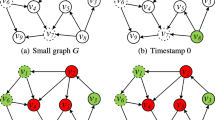Abstract
P2P collusive piracy, where paid P2P clients share the content with unpaid clients, has drawn significant concerns in recent years. Study on the follow relationship provides an emerging track of research in capturing the followee (e.g., paid client) for the blocking of piracy spread from all his followers (e.g., unpaid clients). Unfortunately, existing research efforts on the follow relationship in online social network have largely overlooked the time constraint and the content feedback in sequential behavior analysis. Hence, how to consider these two characteristics for effective P2P collusive piracy prevention remains an open problem. In this paper, we proposed a multi-bloom filter circle to facilitate the time-constraint storage and query of P2P sequential behaviors. Then, a probabilistic follow with content feedback model to fast discover and quantify the probabilistic follow relationship is further developed, and then, the corresponding approach to piracy prevention is designed. The extensive experimental analysis demonstrates the capability of the proposed approach.









Similar content being viewed by others
References
Schollmeier R (2001) A definition of peer-to-peer networking for the classification of peer-to-peer architectures and applications. In: Proceedings of IEEE international conference on peer-to-peer computing, pp 101–102
Lou X, Hwang K (2009) Collusive piracy prevention in P2P content delivery networks. IEEE Trans Comput 58(7):970–983
Abdullah E, Fujita S (2012) Prevent contents leaking in P2P CDNs with robust and quick detection of colluders. J Inf Process 20(2):378–385
Jung E, Cho S (2006) A robust digital watermarking system adopting 2D barcode against digital piracy on P2P network. Int J Comput Sci Netw Secur 6(10):263–268
Basamanowicz J, Bouchard M (2012) Overcoming the Warez paradox: online piracy groups and situational crime prevention. Policy Internet 3(2):1–25
Bellare M, Namprempre C et al (2009) Security proofs for identity-based identification and signature schemes. J Cryptol 22(1):1–61
Yoshida M, Ohzahata S et al. (2010) Controlling file distribution in the share network through content poisoning. In: Proceedings of 24th IEEE international conference on advanced information networking and applications (AINA), pp 1004–1011
Banerjee A, Faloutsos M et al (2008) The P2P war: someone is monitoring your activities. Comput Netw 52(6):1272–1280
Bharambe A, Herley C et al (2006) Analyzing and improving a bittorrent networks performance mechanisms. In: Proceedings of 25th IEEE international conference on computer communications (INFOCOM), pp 1–12
Dugu N, Perez A (2013) Detecting social capitalists on twitter using similarity measures. Complex Netw IV:1–12
Chen J, Nairn R et al (2010) Short and tweet: experiments on recommending content from information streams. In: Proceedings of the 28th ACM international conference on human factors in computing systems, pp 1185–1194
Hannon J, Bennett M et al (2010) Recommending twitter users to follow using content and collaborative filtering approaches. In: Proceedings of the 4th ACM conference on recommender systems, pp 199–206
Kim Y, Shim K et al (2011) A recommendation system for twitter using probabilistic modeling. In: Proceedings of the 11th IEEE international conference on data mining (ICDM), pp 340–349
Armentano M, Godoy D et al (2012) Topology-based recommendation of users in micro-blogging communities. J Comput Sci Technol 27(2):624–634
Yang X, Steck H et al (2012) Circle-based recommendation in online social networks. In: Proceedings of the 18th ACM international conference on knowledge discovery and data mining (SIGKDD), pp 1267–1275
Sandes D, Li W et al (2012) Logical model of relationship for online social networks and performance optimizing of queries. In: Proceedings of 13th international conference on web information systems engineering (WISE), pp 726–736
Golab L, Özsu MT (2013) Issues in data stream management. ACM Sigmod Rec 32(2):5–14
Datar M, Motwani R (2007) The sliding-window computation model and results. Data Streams 149–167
Braverman V, Ostrovsky R, Zaniolo C (2009) Optimal sampling from sliding windows. In: Proceedings of the twenty-eighth ACM SIGMOD-SIGACT-SIGART symposium on principles of database systems, pp 147–156
Aggarwal CC (2007) Data streams: models and algorithms 1–372
Shavitt Y, Weisberg E et al (2011) Mining music from large-scale, peer-to-peer networks. IEEE Multimed 18(1):14–23
Koenigstein N, Shavitt Y (2012) Talent scouting in P2P networks. Comput Netw 56(3):970–982
Koenigstein N, Shavitt Y et al (2012) Measuring the validity of peer-to-peer data for information retrieval applications 56(3):1092–1102
Broder A, Mitzenmacher M (2004) Network applications of Bloom filters: a survey. Internet Math 1(4):485–509
Rottenstreich O, Kanizo Y, Keslassy I (2012) The variable-increment counting Bloom filter. In: INFOCOM 2012, pp 1880–1888
Newman M, Girvan M (2002) Community structure in social and biological networks. Proceedings of the National Academy of Sciences of the United States of America, Vol 99, pp. 7821–7826
Luxburg U (2007) A tutorial on spectral clustering. Stat Comput 17(4):395–416
Woess W (2000) Random walks on infinite graphs and groups. Cambridge University Press, Cambridge
Li Q, Wenjia N et al (2014) Recover fault services via complex service-to-node mappings in wireless sensor networks. J Netw Syst Manag 1–28
Tong E, Niu W et al (2014) Bloom filter-based workflow management to enable QoS guarantee in wireless sensor networks. J Netw Comput Appl 39:38–51
Acknowledgments
This work was partially supported by the Strategic Priority Research Program of the Chinese Academy of Sciences Grant (XDA06030200), the Securing CyberSpaces Research Cluster of Deakin University, Beijing Key Lab of Intelligent Telecommunication Software, Multimedia (No. ITSM201502), Guangxi Key Laboratory of Trusted Software (No. kx201418), and the Major Directionality Project of Chinese Academy of Sciences under Grant (KGZD-EW-102-1)
Author information
Authors and Affiliations
Corresponding authors
Rights and permissions
About this article
Cite this article
Niu, W., Tong, E., Li, Q. et al. Exploring probabilistic follow relationship to prevent collusive peer-to-peer piracy. Knowl Inf Syst 48, 111–141 (2016). https://doi.org/10.1007/s10115-015-0864-1
Received:
Revised:
Accepted:
Published:
Issue Date:
DOI: https://doi.org/10.1007/s10115-015-0864-1




